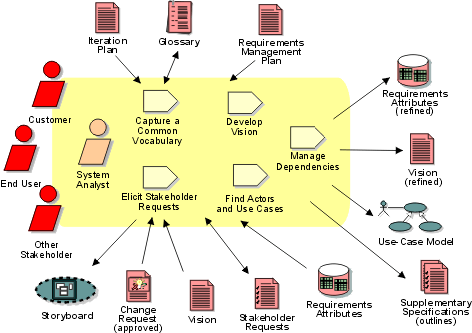Workflow Detail: Understand
Stakeholder Needs
|
The purpose of this workflow detail is to understand the needs of the primary project stakeholders by gathering information about the desired or envisaged product. |
|
|
|
Description

This workflow detail addresses collecting and eliciting information from the
stakeholders in the project in order
to understand what their needs really are. The collected stakeholder requests
can be regarded as a "wish list" that will be used as primary input
to defining the high-level features of your system, as described in the Vision,
which drive the specification of the software requirements,
as described in the use-case model, use cases and supplementary specifications.
(See also: stakeholder requests,
use-case model, use
cases and supplementary specifications).
Typically, this activity is mainly performed during iterations in the Inception and Elaboration phases, however additional stakeholder requests will continue to be gathered throughout the project via Change Requests submitted and approved in accordance with your projects Change-Request Management Process.
The main objective is to elicit stakeholder requests using such input as interviews
business rules,
enhancement requests, and requirements
workshops. The primary outputs are collection(s) of prioritized features and
their critical attributes, which will be used in defining
the system and managing the scope of the system.
(See also: defining the system, managing
system scope,
business rules and the Related
Information section for additional guidance).
This information results in a refinement of the Vision artifact,
as well as a better understanding of the requirements
attributes.
Also, during the enactment of this workflow detail you may start discussing
the functional requirements of the system in terms of its use cases and actors.
Those non-functional requirements, which do not fit appropriately within the
use-case specifications, should be documented in Supplementary Specifications.
(See also: non-functional requirements,
requirements attributes,
use cases and actors).
Another important output is an updated Glossary of terms to facilitate communication through the use of a common vocabulary among team members.
Related Information 
This section provides links to additional information related to this workflow detail.
- Guideline: Brainstorming and Idea Reduction
- Guideline: Interviews
- Guideline: Requirements Workshop
- Guideline: Review Existing Requirements
- Guideline: Role Playing
- Guideline: Storyboarding
- Guideline: Use-Case Workshop
- Concept: User-Centered Design
Timing 
This work is normally addressed early in each iteration.
Optionality 
Should be performed in iterations where the needs of the stakeholders are being discovered or undergoing change.
How to Staff

The project members involved in understanding stakeholder needs should be efficient facilitators and have experience in eliciting information. Of course, familiarity with the targeted technology is desirable, but it is not essential.
Work Guidelines

See the Related Information section for additional guidance that will help you in performing this work.

